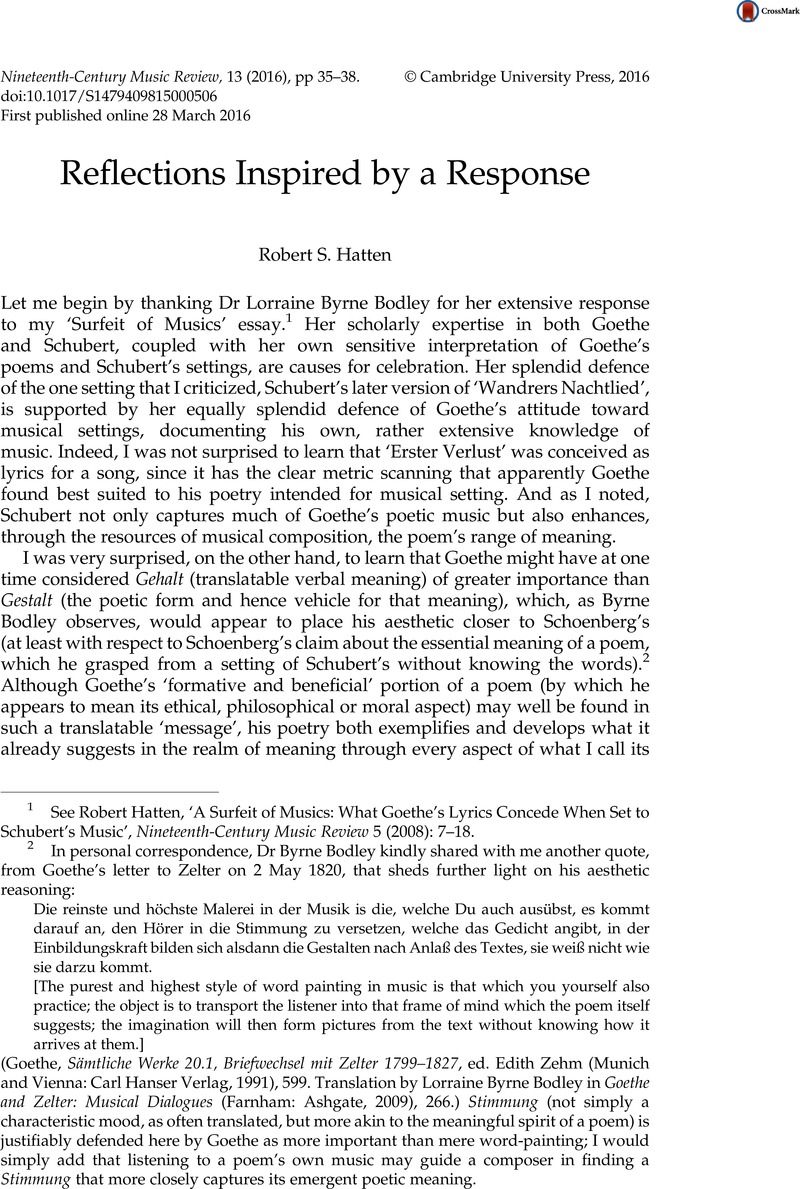Published online by Cambridge University Press: 28 March 2016

1 See Hatten, Robert, ‘A Surfeit of Musics: What Goethe’s Lyrics Concede When Set to Schubert’s Music’, Nineteenth-Century Music Review 5 (2008): 7–18 CrossRefGoogle Scholar.
2 In personal correspondence, Dr Byrne Bodley kindly shared with me another quote, from Goethe’s letter to Zelter on 2 May 1820, that sheds further light on his aesthetic reasoning:
Die reinste und höchste Malerei in der Musik is die, welche Du auch ausübst, es kommt darauf an, den Hörer in die Stimmung zu versetzen, welche das Gedicht angibt, in der Einbildungskraft bilden sich alsdann die Gestalten nach Anlaß des Textes, sie weiß nicht wie sie darzu kommt.
[The purest and highest style of word painting in music is that which you yourself also practice; the object is to transport the listener into that frame of mind which the poem itself suggests; the imagination will then form pictures from the text without knowing how it arrives at them.]
( Goethe, , Sämtliche Werke 20.1, Briefwechsel mit Zelter 1799–1827, ed. Edith Zehm (Munich and Vienna: Carl Hanser Verlag, 1991), 599 Google Scholar. Translation by Lorraine Byrne Bodley in Goethe and Zelter: Musical Dialogues (Farnham: Ashgate, 2009), 266.) Stimmung (not simply a characteristic mood, as often translated, but more akin to the meaningful spirit of a poem) is justifiably defended here by Goethe as more important than mere word-painting; I would simply add that listening to a poem’s own music may guide a composer in finding a Stimmung that more closely captures its emergent poetic meaning.
3 Quoted excerpts are from a passage in Dichtung und Wahrheit, III/2, HA 9: 493, as translated and cited by Byrne Bodley in her response (see her article in this issue, p. 000).
4 MacLeish’s poem first appeared in Poetry: A Magazine of Verse (June 1926): 126–7. Among twentieth-century critics, John Ciardi most elegantly addresses this issue: ‘WHAT DOES THE POEM MEAN? is too often a self-destroying approach to poetry. A more useful way of asking the question is HOW DOES A POEM MEAN? Why does it build itself into a form out of images, ideas, rhythms? How do these elements become the meaning? How are they inseparable from the meaning? As Yeats wrote: ‘O body swayed to music, o quickening glance,/How shall I tell the dancer from the dance?’ What the poem is, is inseparable from its own performance of itself’. Ciardi, John, How Does a Poem Mean? (An Introduction to Literature, Part 3), (Boston: Houghton Mifflin, 1959), 667–668 Google Scholar.
Robert Frost spoke about his discovery of this inseparability in relation to the first poem he published: ‘I can remember in that poem the first sense I had of the nicety of the words –that nobody else – that I couldn’t myself say differently. That is to say, I couldn’t translate it even into other English’. Excerpt from a lecture in Hanover, New Hampshire, December 15, 1954, in Robert Frost Speaking on Campus: Excerpts from His Talks, 1949–1962, ed. Edward C. Lathem (New York: Norton, 2009), 57.
5 Hatten, , ‘A Surfeit of Musics’, 10 Google Scholar.
6 Robert Frost’s concept of ‘sentence sounds’, developed in his letters early in his career, refers to the characteristic gestures of vocal intonation that accompany familiar phrases of spoken language. See Sears, John F., ‘Robert Frost and the Imagists: The Background of Frost’s “Sentence Sounds”’, The New England Quarterly, 54 (1981), 467 CrossRefGoogle Scholar. These characteristic tones or intonations provide a supplement or at times a substitute for metric schemes of scansion. Sentence sounds (in this sense) have enlivened spoken verse from at least the time of Shakespeare.
7 Hatten, ‘A Surfeit of Musics’, 10.
8 Langer’s first presentation of the ‘unconsummated symbol’ appears in section VIII of Philosophy in a New Key: A Study in the Symbolism of Reason, Rite, and Art (Cambridge, MA: Harvard University Press, 1942): 204–45, where she also argues that the presentational symbol (as opposed to the discursive symbol) cannot be translated, and that form and content in music are inseparably experienced as one. See also Feeling and Form: A Theory of Art Developed from Philosophy in a New Key (New York: Scribner’s, 1953).
9 See Hatten, , Musical Meaning in Beethoven: Markedness, Correlation, and Interpretation (Bloomington: Indiana University Press, 1994), 18 Google Scholar, 56–63, and 96, for various forms and interpretations of this chromatic reversal, as used in different contexts.
10 By transmedialization, I refer to the artistic transfer of a poetic text from its original media (as visually read or verbally spoken) to a recontextualization within the divergent media of composed vocal and instrumental music. To the extent a composer wishes to preserve significant features of the original poetic music, its form, and its expressive meaning, the composer could be understood as ‘translating’ the poem into musical terms, or more extremely, as creating an ekphrasis or secondary representation of the poem. For more on the complexities of transmedialization and ekphrasis, see Bruhn, Siglind, Musical Ekphrasis: Composers Responding to Poetry and Painting (Hillsdale, NY: Pendragon, 2000)Google Scholar.
For more on the variety of potential interactions among different artistic media in a given work (including those works originally conceived as multimedial) see Cook, Nicholas, Analysing Musical Multimedia (Oxford: Oxford University Press, 1998)Google Scholar. His perspective highlights difference and contrast between media, and he values interactions that move beyond (mere) conformance to more interesting kinds of complementation and contest (98–106). For Cook, ‘contest’ is more characteristic of the relationship between text and music in classical art song (104); these composers presumably look for poetic texts that are sufficiently ‘gapped’ as to provide room for music (105). Needless to say, my perspective on ‘Wandrers Nachtlied’ would suggest Goethe’s poem is not sufficiently gapped in Cook’s sense.
11 The complete title is Le Ton beau de Marot: In Praise of the Music of Language (New York: Basic Books, 1997).